英语课程与教学论_Unit Nine Teaching Vocabulary_Unit
《英语课程与教学论》
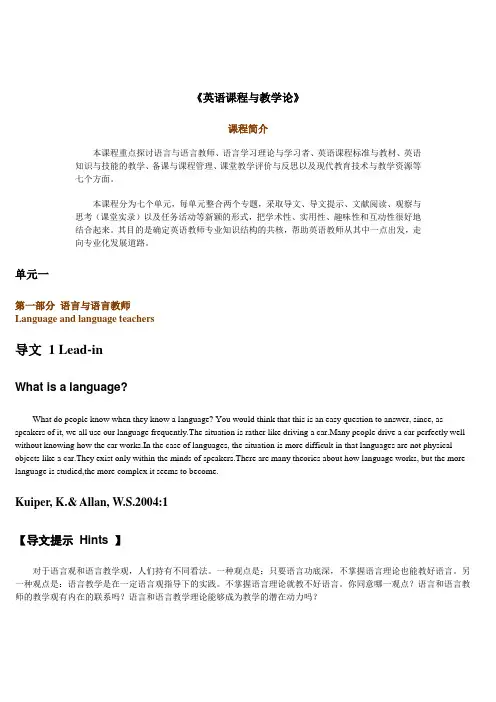
《英语课程与教学论》课程简介本课程重点探讨语言与语言教师、语言学习理论与学习者、英语课程标准与教材、英语知识与技能的教学、备课与课程管理、课堂教学评价与反思以及现代教育技术与教学资源等七个方面。
本课程分为七个单元,每单元整合两个专题,采取导文、导文提示、文献阅读、观察与思考(课堂实录)以及任务活动等新颖的形式,把学术性、实用性、趣味性和互动性很好地结合起来。
其目的是确定英语教师专业知识结构的共核,帮助英语教师从其中一点出发,走向专业化发展道路。
单元一第一部分语言与语言教师Language and language teachers导文 1 Lead-inWhat is a language?What do people know when they know a language? You would think that this is an easy question to answer, since, as speakers of it, we all use our language frequently.The situation is rather like driving a car.Many people drive a car perfectly well without knowing how the car works.In the case of languages, the situation is more difficult in that languages are not physical objects like a car.They exist only within the minds of speakers.There are many theories about how language works, but the more language is studied,the more complex it seems to become.Kuiper, K.& Allan, W.S.2004:1【导文提示Hints 】对于语言观和语言教学观,人们持有不同看法。
英语课程与教学论(1)
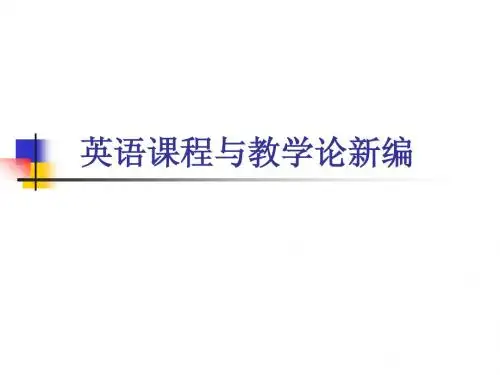
(2)Theory of learning
The theory of learning underlying the Grammar-Translation Method was Faculty Psychology.
3. Basic Principles
(1)Main features (2)Objectives (3)Techniques (4)Exemplification
The Grammar-Translation Method
1. 2. 3. 4. Background Theoretical Basis Basic Principles Summary and Comments
1. Background
(1)The history of the Grammar-Translation Method is not fully and carefully documented. However, there is evidence that grammar analysis and translation began to be the basic procedures in foreign language teaching from the 16th century. (2)The second impetus for the procedures of grammar analysis and translation in teaching Latin came from the social needs of European countries.
英语课程与教学论新编
Chapter 12
Schools of English Teaching Methodology
《英语课程与教学论》
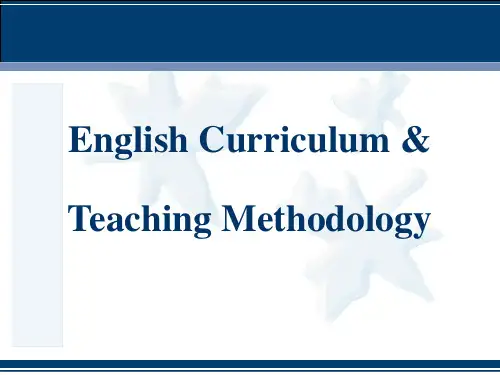
I Views on language learning
Behaviorist theory B.F. Skinner (1904—1990) Skinner suggested language is also a form of behaviour. It can be learned the same way as an animal is trained to respond to stimuli. Stimulus-Response-Reinforcement
I How do we learn languages?
• The way language teachers teach in the classroom is to some extent influenced by the way they learned languages.
Task 1 Questionnaire
Final Score
1. Presentation 10% 2. Homework & Test 20% 3. Final Exam 70% 4. A Research Paper 5. Research Activity
Unit I Language and Language Teachers
III What is a good language teacher?
• Work in groups. Reflect on your own learning experiences from early school years to the university. • Have you had an excellent English teacher? Try to identify as many qualities as possible of your best English teacher(s). • Note down all the qualities that you think
英语课程教学论Unit 9
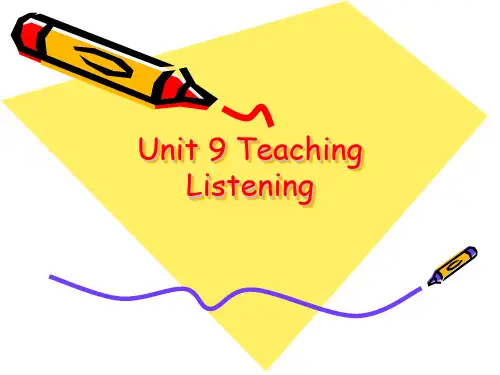
characteristics of the listening process
• Spontaneity: we listen to people speaking spontaneously and informally without rehearsing. • Context: relationship between speakers; situation • Visual clues: facial expressions, gestures, other body language as well as the surrounding environment • Listener’s response: interrupt, ask for repetition or clarification • Speaker’s adjustment: adjust the way of speaking, rephrase or elaborate
Post-listening activities:
• • • • Multiple-choice questioins Answering questions Note-taking and gap-filling Dictogloss: preparation; dictation; reconstruction; analysis and correction
While-listening activities:
• • • • • • • • • The teacher provides a reason, goal or task for learner. No specific responses Listen and tick Listen and sequence Listen and act Listen and draw Listen and fill Listen and take notes Listen and guess
《英语课程与教学论》研究生课程教学大纲
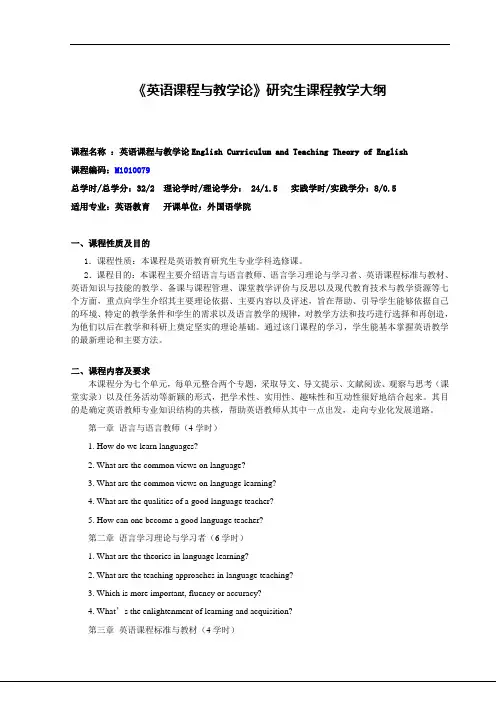
《英语课程与教学论》研究生课程教学大纲课程名称:英语课程与教学论English Curriculum and Teaching Theory of English课程编码:M1010079总学时/总学分:32/2 理论学时/理论学分: 24/1.5 实践学时/实践学分:8/0.5适用专业:英语教育开课单位:外国语学院一、课程性质及目的1.课程性质:本课程是英语教育研究生专业学科选修课。
2.课程目的:本课程主要介绍语言与语言教师、语言学习理论与学习者、英语课程标准与教材、英语知识与技能的教学、备课与课程管理、课堂教学评价与反思以及现代教育技术与教学资源等七个方面,重点向学生介绍其主要理论依据、主要内容以及评述,旨在帮助、引导学生能够依据自己的环境、特定的教学条件和学生的需求以及语言教学的规律,对教学方法和技巧进行选择和再创造,为他们以后在教学和科研上奠定坚实的理论基础。
通过该门课程的学习,学生能基本掌握英语教学的最新理论和主要方法。
二、课程内容及要求本课程分为七个单元,每单元整合两个专题,采取导文、导文提示、文献阅读、观察与思考(课堂实录)以及任务活动等新颖的形式,把学术性、实用性、趣味性和互动性很好地结合起来。
其目的是确定英语教师专业知识结构的共核,帮助英语教师从其中一点出发,走向专业化发展道路。
第一章语言与语言教师(4学时)1. How do we learn languages?2. What are the common views on language?3. What are the common views on language learning?4. What are the qualities of a good language teacher?5. How can one become a good language teacher?第二章语言学习理论与学习者(6学时)1. What are the theories in language learning?2. What are the teaching approaches in language teaching?3. Which is more important, fluency or accuracy?4. What’s the enlightenment of learning and acquisition?第三章英语课程标准与教材(4学时)1. What is curriculum?2. What’s the difference between curriculum and syllabus?3. What’s the difference between the teaching of coursebooks and teaching by the use of thecoursebooks?第四章英语知识与技能的教学(8学时)1. What is language system? How to present the language system?2. What are the objectives of teaching pronunciation?3. How to teach language skills?第五章备课与课程管理(4学时)1. Lesson plan2. Classroom management第六章课堂教学评价与反思(4学时)1. Testing & Assessment2. Evaluation & Reflection第七章现代教育技术与教学资源(2学时)1. Educational technology2. CALL三、教学使用教材1.魏立明.新世纪教师教育系列教材·英语课程与教学论. 东北师范大学出版社, 2005.2.鲁子问.英语教学论(第2版)(英文版).上海:华东师范大学出版社,2010.四、学习要求学生在学的过程中要及时进行预习和复习,并可根据教师提供的参考书目进行相关章节的课后拓展学习,积极使用网络平台,查找资料,也可以加入高校及英语课程与教学论爱好者创办的相关论坛,参加网上讨论,充分利用网上的资源。
英语课程与教学论教学大纲
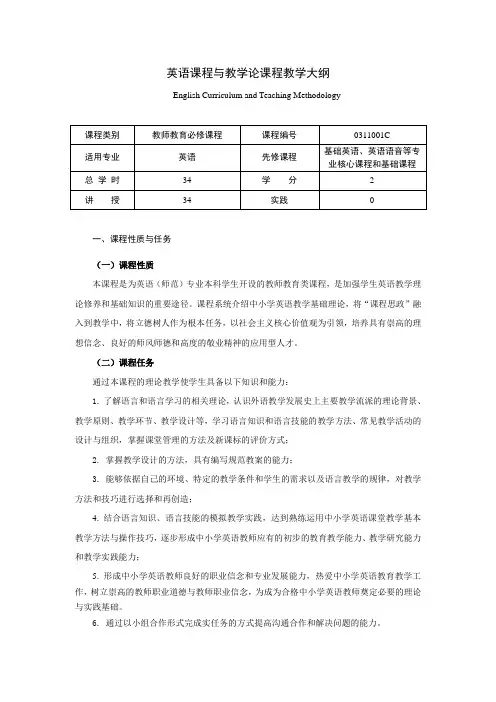
英语课程与教学论课程教学大纲English Curriculum and Teaching Methodology一、课程性质与任务(一)课程性质本课程是为英语(师范)专业本科学生开设的教师教育类课程,是加强学生英语教学理论修养和基础知识的重要途径。
课程系统介绍中小学英语教学基础理论,将“课程思政”融入到教学中,将立德树人作为根本任务,以社会主义核心价值观为引领,培养具有崇高的理想信念、良好的师风师德和高度的敬业精神的应用型人才。
(二)课程任务通过本课程的理论教学使学生具备以下知识和能力:1.了解语言和语言学习的相关理论,认识外语教学发展史上主要教学流派的理论背景、教学原则、教学环节、教学设计等,学习语言知识和语言技能的教学方法、常见教学活动的设计与组织,掌握课堂管理的方法及新课标的评价方式;2. 掌握教学设计的方法,具有编写规范教案的能力;3. 能够依据自己的环境、特定的教学条件和学生的需求以及语言教学的规律,对教学方法和技巧进行选择和再创造;4. 结合语言知识、语言技能的模拟教学实践,达到熟练运用中小学英语课堂教学基本教学方法与操作技巧,逐步形成中小学英语教师应有的初步的教育教学能力、教学研究能力和教学实践能力;5. 形成中小学英语教师良好的职业信念和专业发展能力,热爱中小学英语教育教学工作,树立崇高的教师职业道德与教师职业信念,为成为合格中小学英语教师奠定必要的理论与实践基础。
6. 通过以小组合作形式完成实任务的方式提高沟通合作和解决问题的能力。
二、教学活动目标(一)课程目标通过本课程的理论教学,使学生具备下列能力:课程目标1:能够运用外语教学基本理论和外语学习理论,根据需要运用恰当的教学方法和技巧,具有编写教案、课堂管理和教学评价的能力。
(支撑毕业要求指标点1-4)课程目标2:未来能够成为具有良好的师风师德,较强的法制观念和诚信意识的合格的教师。
(支撑毕业要求指标点2-2)课程目标3:能够熟练准确地运用英语语言进行教学,发出课堂指令,恰当地对学生予以评价。
《英语课程与教学论》教学大纲
《英语课程与教学论》教学大纲课程编号:12100917学时:32学分:2课程类别:专业方向模块课程面向对象:英语专业本科学生课程英文名称:The English Curriculum and Teaching Theories一、课程的任务和目的任务:通过该课程学习,引导师范生学习课程教学改革新理念,帮助树立交际语言教学观;学习语言学、心理学、二语习得等外语教学理论和外语学习理论,奠定良好的教学理论基础;学习不同的英语教学法思想,掌握英语课堂交际语言教学技能;组织学生参加英语教学实践活动,帮助学生理论联系实际教学, 培养学生实践教学和反思教学能力,逐步提高对英语教学的认识能力,从而形成个人所特有的英语课堂教学能力,为将来从事英语教育事业奠定良好的理论和实践基础。
目的:该课程旨在培养英语师范生具有英语交际语言教学观,具备在新课程改革的教学理念指导下的英语课堂交际语言教学技能, 为将来从事英语教育事业奠定良好的理论和实践基础,成为能够适应社会发展需要的合格的英语教师。
二、课程教学内容与要求1.绪论明确开设本课程的目的,介绍本课程的特点、体系及研究和学习的任务;使学生了解英语教师形成自己的教学艺术风格的途径。
2.外语教学法的主要流派,特别是交际语言教学法。
集中学习各种英语教学方法中的教学活动及其涉及教与学方面的有关问题,使学生了解各种教学法的原则和具体的操作方法,了解其优缺点,以便能在教学实际中选用正确的方法进行教学。
3.英语课程标准英语课程标准是教材编写,教学教研,测试评估的依据,因此全面细致地学习英语课程标准是首要工作。
通过学习,学生明确英语课程标准“新”在何处,了解英语课程标准的教学目的,教学要求和原则。
4.英语现行教材及驾驭教材的具体教学方法和技巧介绍中学英语现行教材编写的指导思想,要求学生掌握教材的基本特点。
在此基础上,介绍中学英语现行教材的具体课堂教学方法和技巧,要求学生掌握如何进行听,说,读、写技能的训练,如何进行词汇,句型、语法的教学,如何使用简笔画、电化设备等辅助教学手段。
英语教学法教程9 Teaching Listening(课堂PPT)
formats) 6. Manage strategy use: self-evaluate; share
experiences
11
12
Unit 9 Teaching Listening
1. Why does listening seem so difficult for students?
2. What do we listen to in everyday life? 3. What are the characteristics of the
Demonstrate to the class next week. For Group 7.
3
A revision of Teaching Vocabulary
1. What are some of the assumptions about vocabulary learning?
2. What does knowing a word involve? 3. How can we present new vocabulary
10
8.5 How do we help students develop vocabulary learning strategies?
1. Review regularly 2. Guess meaning from context
contextual clue: the topic, the grammatical structure, meaning connect between the given word and other words, linguistic pattern
英语课程与教学论章兼中重点
英语课程与教学论章兼中重点摘要:一、引言1.英语课程与教学论的重要性2.本文的目的和结构二、英语课程的目标和内容1.英语课程的总目标2.英语课程的具体内容三、英语教学的方法和策略1.交际式教学法2.任务型教学法3.语法翻转教学法四、英语课程的评价体系1.形成性评价2.终结性评价3.评价方法的选择和应用五、英语课程与教学论在我国的现状与发展趋势1.我国英语课程与教学论的现状2.英语课程与教学论的发展趋势3.对我国英语课程与教学论的建议六、结论1.英语课程与教学论的关键要点2.对英语教师和教育工作者的启示正文:英语课程与教学论是英语教育领域中的重要组成部分,它关注英语课程的设置、教学方法的选择、教学策略的制定以及课程评价等问题。
本文旨在通过对英语课程与教学论的研究,帮助英语教师和教育工作者更好地理解和应用英语教学理论和实践。
英语课程的总目标是培养学生的语言应用能力,使他们能在日常生活、学习和工作中熟练地使用英语进行交际。
为实现这一目标,英语课程设置了听、说、读、写、译等各方面的具体内容。
其中,听和说是英语教学的重点,也是学生最难掌握的部分。
在英语教学过程中,教师需要采用适当的教学方法和策略。
交际式教学法、任务型教学法和语法翻转教学法是三种常用的教学方法。
交际式教学法强调学生在语言交流中的主体地位,教师要为学生提供真实、自然的语言环境。
任务型教学法强调通过完成各种任务来培养学生的语言应用能力,教师要设计富有挑战性和实际意义的任务。
语法翻转教学法则要求教师将语法知识融入学生的语言实践中,让学生在实际运用中发现和掌握语法规则。
英语课程的评价体系包括形成性评价和终结性评价。
形成性评价主要通过课堂观察、学生作品、口语测试等方式进行,旨在了解学生的学习进度和成长需求。
终结性评价主要通过期末考试、升学考试等方式进行,旨在对学生的学习成果进行总结和鉴定。
评价方法的选择和应用要依据课程目标、教学内容和教学方法进行,力求全面、客观、公正。
大三英语课程与教学论
大三英语课程与教学论
大三英语课程与教学论(English Curriculum and Teaching Theory in the Third Year)是针对大三学生开设的一门英语教
育学类课程。
该课程旨在帮助学生全面了解和掌握英语教学的理论和实践,提高他们的英语教育教学能力。
在大三英语课程与教学论中,学生将学习以下内容:
1. 教育学基础知识:介绍教育学的基本概念、原理和理论,包括教育心理学、教育学原理等。
2. 英语教育理论:探讨英语教学的目标、原则和方法,包括英语教学法、教学策略等。
3. 教学设计与评价:讲解教学设计的原则和步骤,培养学生设计教学活动和评价学生学习成果的能力。
4. 教学资源与工具:介绍英语教学所需的各种教学资源和工具,如教材、多媒体技术等。
5. 实践与反思:通过实践教学活动和案例分析,使学生能够反思并改进自己的教学方法和策略。
在教学过程中,教师会引导学生积极参与课堂讨论、小组活动和实践教学,通过案例分析和教学实践的反思,培养学生的问题解决能力和专业素养。
同时,通过阅读相关文献,学生还将了解到国内外英语教育的最新动态和研究成果。
大三英语课程与教学论为学生打下坚实的英语教育理论基础,提高他们的英语教学能力和专业素养,为以后从事英语教育相关工作打下扎实的基础。
- 1、下载文档前请自行甄别文档内容的完整性,平台不提供额外的编辑、内容补充、找答案等附加服务。
- 2、"仅部分预览"的文档,不可在线预览部分如存在完整性等问题,可反馈申请退款(可完整预览的文档不适用该条件!)。
- 3、如文档侵犯您的权益,请联系客服反馈,我们会尽快为您处理(人工客服工作时间:9:00-18:30)。
13
Summary
● Importance of vocabulary in language learning ●Assumptions about vocabulary learning ●Elements related to knowing a word
2
Aims for this time
At the end of this time, you will be able to know: ● the importance of vocabulary in language learning; ● some assumptions about vocabulary learning; ● what knowing a word involves.
14
Homework
●Go over the today’s contents and read more about vocabulary teaching.
●Preview the rest parts of Unit 9.
15
3
●Importance of vocabulary
➢“Without grammar very little can be conveyed, without vocabulary nothing can be conveyed.” (D.A. Wilkins)
➢Words are bricks to a language. ➢Words build meaning and convey thoughts.
4
● Some common assumptions about vocabulary
➢ Avocabulary item can be more than one word. ➢ Languages consist of “words” with equivalents from one language to another . ➢Vocabulary cannot be taught. It must be learned by the individuals. ➢ Both teachers and students need to know that there is a difference between
Collocations Synonyms Antonyms Hyponyms Receptive
& productive vocabulary
Denotative meaning
• The primary, literal or explicit meaning • Those words that we use to label things as
• words that one is able to recognize and comprehend in reading or listening but unable to use automatically in speaking or writing
12
Productive vocabulary
regards real objects, such as a name or a sign, etc. in the physical world
7
Connotative meaning
• The meaning of a word or phrase that is suggested or implied, as opposed to a denotation, or literal meaning
• Antonyms: items that mean the opposite ords which can be grouped together under the same superordinate concept
11
Receptive vocabulary
8
Collocations
• Words that co-occur with high frequency and have been accepted as ways for the use of words
9
• Synonyms: items that mean the same, or nearly the same
Unit 9 Teaching Vocabulary(1)
1
Aims for the unit
At the end of the unit , you will be able to know: ●what knowing a word involves; ●ways to present new vocabulary items; ●ways to consolidate vocabulary; ●vocabulary learning strategies.
active and passive vocabulary. ➢The best way to explain vocabulary is to translate. ➢ English-English explanations are the best for vocabulary teaching.
5
● What does knowing a word involve?
Aword
Form
Meaning
Pronunciation & stress
Spelling & grammatical properties
Denotative &
Connotative
One morphem
e
More than one morpheme with different bound
